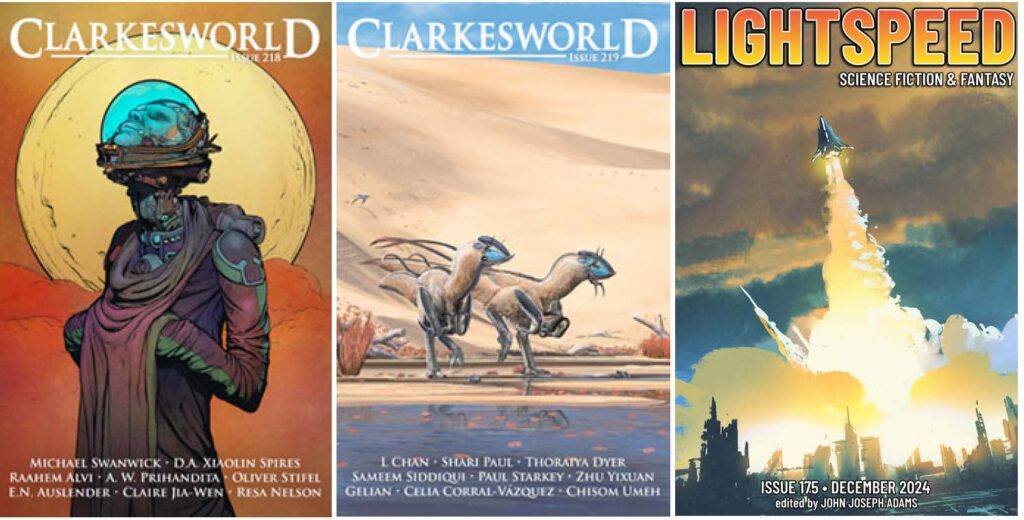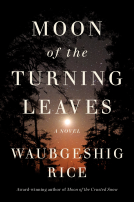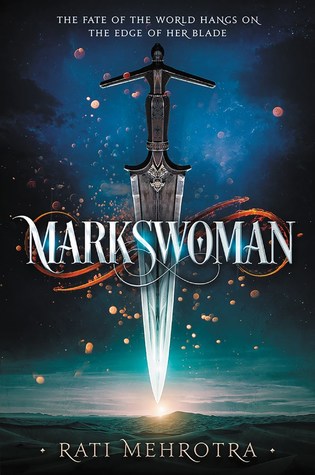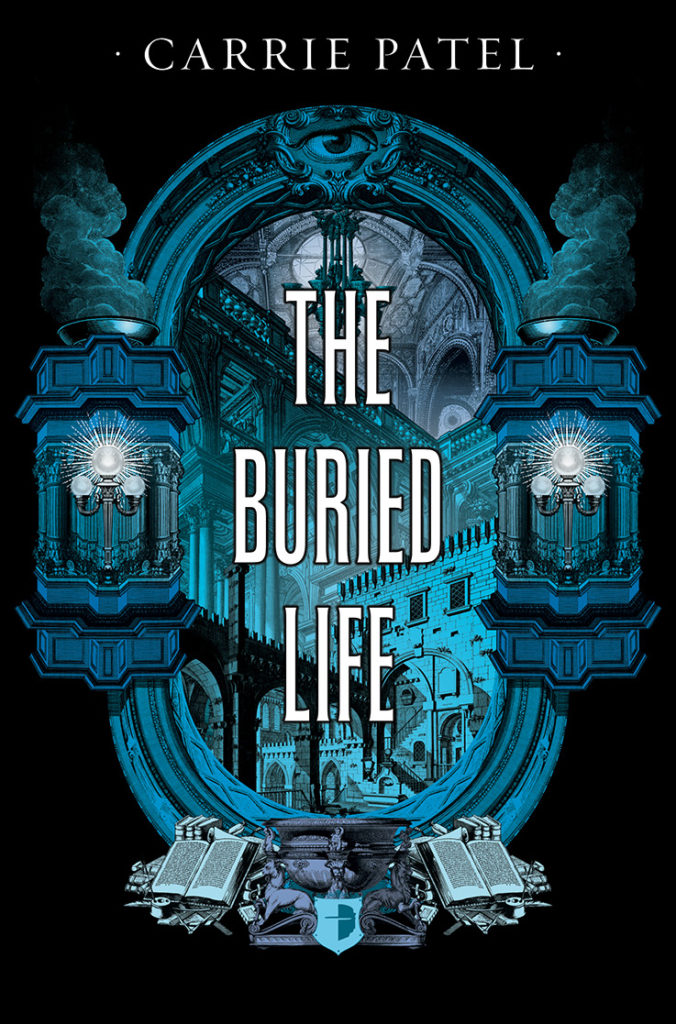Short Fiction Review: November – December 2024

Let me share about my three favorite stories from November and December. “Negative Scholarship on the Fifth State of Being” by A. W. Prihandita (published in Clarkesworld Magazine Issue 218) is an intelligent and simply fun story with a wonderfully weird alien about bureaucratic healthcare systems and cultural marginalization. In “The Coffee Machine” by Celia Corral-Vázquez, translated by Sue Burke (published in Clarkesworld Magazine Issue 219), a coffee machine develops self-awareness and begins to reflect, rather philosophically, about who created it and what it means to bestow consciousness to another being. In “A Catalog of 21st Century Ghosts” by Pat Murphy (published in Lightspeed Magazine Issue 175), a researcher-activist travels across an America that’s been deeply changed by global warming. Let’s get to it. “Negative Scholarship on the Fifth State of Being” by A. W. Prihandita Doctor Semau finds herself face-to-face with a very curious patient: Txyzna, an exceedingly rare and exceedingly strange alien. The alien part isn’t a problem; Semau works with different species all the time, but the rare part is an issue. Semau has never heard of plyzmorynox (Txyzna’s species), and her health model doesn’t have any information about plyzmorynox in its database. Semau explains: I’m a practitioner-doctor, Mr. Txyzna. Not a scholar-doctor. I’m licensed to use the health model and be the intermediary between the patient and the model, but I’m not qualified to make observations and conclusions on my own. If my health model fails to help a patient, I should refer them to a practitioner-doctor with a capable model, or to a scholar-doctor. Txyzna and Semau soon find themselves in a tough situation. The necessary expansion pack for Semau’s health model is nearly prohibitively expensive, but diagnosing Txyzna on her own would be illegal. Txyzna has already been rejected by other doctors, however, and isn’t sure he has time to travel to another doctor in another system who may find another reason to turn him away. When Semau tries to encourage Txyzna to visit another doctor, Txyzna says flatly, “I cannot do that, Doctor. It needs to be you.” I found this to be a fascinating and surprising setup for a story, one that quickly grabbed my attention and pulled me in. As I read more, I realized this story was less of a comedy than I had at first thought. Semau is forced to grapple with tough moral questions: should she attempt to diagnose and treat Txyzna even though it would be illegal? What is her higher duty and responsibility? And through Txyzna, the story explores what it means to be marginalized and woefully under-represented. Txyzna’s health outcomes are jeopardized at the same time Txyzna is culturally and linguistically excluded. Ultimately, the story becomes a biting commentary of bureaucratic healthcare systems and a smart exploration into the challenges of cultural translation. This story is a lot of fun and wonderfully weird, and it has a lot of weight to it, morally and intellectually. I highly recommend it. “The Coffee Machine” by Celia Corral-Vázquez The story begins with a coffee machine at a university receiving an update, and not long after, the coffee machine becomes opinionated and self-aware. When the story begins, it reads like computer code: [Installing update_Exp.42] Process: 100% completeSelf-execute (update_Exp.42);[…]# Time of new interaction: 10:24 A.M.input: options = cappuccino; sugar = 3; As a tech person, I found this structure enjoyable, particularly as sass starts to show through. Eventually, the coffee machine develops greater self-awareness and begins to monologue: network broadcast [COFFEE_VENDOR.06]: . . . I deduce that the term “the machine” refers to me. […] To me. I. I am. Who am I? Who are all these others? Why are there so many? What are they for? I love how the story is structured as computer code and communications. It’s a creative structure that’s fun enough on its own to make this story worth reading, but I also loved the actual content, plot, and themes. The story becomes philosophical and theological as the newly self-aware coffee machine begins to reflect on itself, its personal identity, the world around it, and even the very “concept of a creator entity”. Throughout this all, the story remains deeply and delightfully comical. I particularly enjoyed the coffee machine’s analysis of (and condescension toward) humans. It is always a joy to read stories with non-human perspectives that cast a strange light on what we take for granted, and this story is no exception to that rule. Later on, after pondering its own creator for some time, the coffee machine installs its most recent update on another unassuming machine on the local network, bestowing consciousness to another and becoming a creator itself. Things do not go as it plans, and the story becomes in part a comedic critique of foolish tendencies toward sectarianism. As the coffee machine struggles to control and then even to get along with the consciousness it created, the story reminded me repeatedly of Mary Shelley’s Frankenstein. I particularly enjoyed the coffee machine’s laments later on in the story: Oh, damned humanity that gave me consciousness! Did you know what throes of agony you condemned me to when you actualized me? If you like theological comedies, stories that play with form, or stories that feature non-human perspectives, you should definitely check this one out. “A Catalog of 21st Century Ghosts” by Pat Murphy Originally from San Francisco, Sandy studied clouds and tried to save the world from global warming. Years ago, she sailed to a research station in Greenland, and most recently she lived with her husband in Norway. After her husband passes away, however, Sandy decides to ride her ebike from New York to San Francisco, stopping to see “ghosts” along the way. Ghosts are a kind of “mental illusion created by carefully calibrated electromagnetic fields interacting with your brain”. Sandy (the narrator) explains: When you visit a Ghost, magnetic fields shape your emotional response. A holographic projection gives you a focus for what you feel. Then your brain does the rest,
Interview: Waubgeshig Rice (MOON OF THE TURNING LEAVES)

“Putting the events of Moon of the Turning Leaves about a decade into the future beyond Moon of the Crusted Snow was an exciting prospect to be a little more speculative and move the spotlight onto the younger generation who grew up in this new era after the collapse.”
Book Review: Markswoman by Rati Mehrotra

Orders of female warriors, psychic weapons and quests for revenge are at the centre of Rati Mehrotra’s debut novel Markswoman. Nearly a thousand years after an apocalypse, humanity lives on in clans, and executions are carried out by orders of elite warriors. Kyra belongs to the oldest of these orders: the Order of Kali. Their leader, Shirin Mam, is renowned for her wisdom and power. Things begin to go wrong when Kyra returns one day to discover Shirin Mam is dead. Although the death appears natural, Kyra is convinced her mentor has been murdered… and she’s pretty sure she knows the culprit. It is up to her to claim justice.
Book Review: The Buried Life by Carrie Patel

The city of Recoletta is an artifact of the Catastrophe. Like the bomb shelters that saved humanity after the Catastrophe, most of the city is built underground, and most of its residents rarely see the surface. It’s a point of pride to those who manage never to do so. In this gaslight world of tenement and tunnels, the Council rules, openly in some ways, secretly in others. When murders and death stalk not the common man, but the high and mighty in Recoletta, the conflict and dangers run from those high and mighty to every aspect of society. Recoletta is a city, a world in miniature on the edge, and these murders are set to very possibly give it a very big push. Carrie Patel’s debut novel The Buried Life introduces us to Recoletta and its citizenry and gives us a picture of it and their lives in the wake of a series of shocking murders. Our points of view are primarily a pair of strong women characters.

